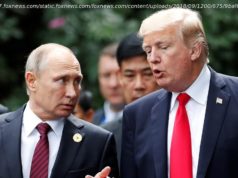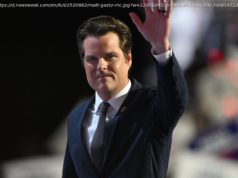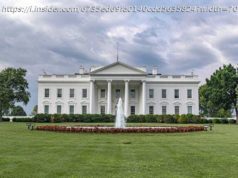After 2 ½ months of relative quiet, North Korea launched its most powerful weapon yet early Wednesday, claiming a new type of intercontinental ballistic missile that some observers believe…
By KIM TONG-HYUNG and FOSTER KLUG Associated Press
SEOUL, South Korea (AP) — After 2 ½ months of relative quiet, North Korea launched its most powerful weapon yet early Wednesday, claiming a new type of intercontinental ballistic missile that some observers believe could reach Washington and the entire eastern U. S. seaboard.
In a special state media broadcast hours later, North Korea said it successfully fired a «significantly more» powerful, nuclear-capable ICBM it called the Hwasong-15. Outside governments and analysts concurred the North had made a jump in missile capability.
A resumption of Pyongyang’s torrid testing pace in pursuit of its goal of a viable arsenal of nuclear-tipped missiles that can hit the U. S. mainland had been widely expected, but the power of the missile and suddenness of the test still jolted the Korean Peninsula and Washington. The launch at 3:17 a.m. local time and midday in the U. S. capital indicated an effort to perfect the element of surprise and to obtain maximum attention in the United States.
In a government statement released through state media, North Korea said the Hwasong-15, the «greatest ICBM,» could be armed with a «super-large heavy nuclear warhead» and is capable of striking the «whole mainland» of the United States. The North said the missile reached a height of 4,475 kilometers (2,780 miles) and traveled 950 kilometers (590 miles) before accurately hitting a sea target, similar to the flight data announced by South Korea’s military.
It said leader Kim Jong Un after the successful launch «declared with pride» that the country has achieved its goal of becoming a «rocket power.» State TV said Kim gave the order on Tuesday and broadcast a photo of Kim’s signed order where he wrote: «Test launch is approved. Taking place at the daybreak of Nov. 29! Fire with courage for the party and country!»
The firing is a clear message of defiance aimed at the Trump administration, which a week earlier had restored North Korea to a U. S. list of terror sponsors. It also ruins nascent diplomatic efforts, raises fears of war or a pre-emptive U. S. strike and casts a deeper shadow over the security of the Winter Olympics early next year in South Korea.
A rattled Seoul responded by almost immediately launching three of its own missiles in a show of force. President Moon Jae-in expressed worry North Korea’s missile threat could force the United States to attack the North before it masters a nuclear-tipped long-range missile, something experts say may be imminent.
«If North Korea completes a ballistic missile that could reach from one continent to another, the situation can spiral out of control,» Moon said at an emergency meeting in Seoul, according to his office. «We must stop a situation where North Korea miscalculates and threatens us with nuclear weapons or where the United States considers a pre-emptive strike.»
Moon has repeatedly declared the U. S. cannot attack the North without Seoul’s approval, but many here worry Washington may act without South Korean input.
The launch was North Korea’s first since it fired an intermediate-range missile over Japan on Sept. 15 and may have broken any efforts at diplomacy. U. S. officials have sporadically floated the idea of direct talks with North Korea if it maintained restraint.
The missile also appears to improve on North Korea’s past launches.
If flown on a standard trajectory, instead of Wednesday’s lofted angle, the missile would have a range of more than 13,000 kilometers (8,100 miles), said U. S. scientist David Wright, a physicist who closely tracks North Korea’s missile and nuclear programs. «Such a missile would have more than enough range to reach Washington, D. C., and in fact any part of the continental United States,» Wright wrote in a blog post for the Union for Concerned Scientists.
North Korea’s description of a «super-large heavy» warhead could raise debate on whether it plans another nuclear test to demonstrate it has such a weapon. When the North flight-tested two of its older ICBM models, the Hwasong-14s, in July, it said the missiles were capable of delivering «large-sized heavy» warheads. The North went on to conduct its sixth and most powerful nuclear test on Sept. 3, which it described as a detonation of a weapon built for ICBMs.
South Korea’s National Intelligence Service told lawmakers in a closed-door briefing the possibility of a nuclear test «cannot be discounted,» lawmaker Kim Byung-kee said.
The missile was launched from near Pyongyang, and Japanese Defense Minister Itsunori Onodera said it landed inside of Japan’s special economic zone in the Sea of Japan, about 250 kilometers (155 miles) west of Aomori, which is on the northern part of Japan’s main island of Honshu.
A big unknown, however, is the missile’s payload. If, as expected, it carried a light mock warhead, then its effective range would have been shorter, analysts said.
The analyses of Wednesday’s test suggest progress by Pyongyang in developing a weapon of mass destruction that could strike the U. S. mainland. President Donald Trump has vowed to prevent North Korea from having that capability — using military force if necessary.
Kim Dong-yub, a former South Korean military official who is now an analyst at Seoul’s Institute for Far Eastern Studies, said the missile is likely an upgraded version of its old ICBM with an enhanced second-stage. He believes the North will try to evaluate the weapon’s performance, including the warhead’s ability to survive atmospheric re-entry and strike the intended target, before it attempts a test that shows the full range of the missile.
In response to the launch, Trump said the United States will «take care of it.» He told reporters after the launch: «It is a situation that we will handle.» He did not elaborate.
The U. N. Security Council scheduled an emergency meeting for Wednesday afternoon at the request of Japan, the U. S. and South Korea.
When the Trump administration declared North Korea a state sponsor of terrorism, the U. S. also imposed new sanctions on North Korean shipping firms and Chinese trading companies dealing with the North.






